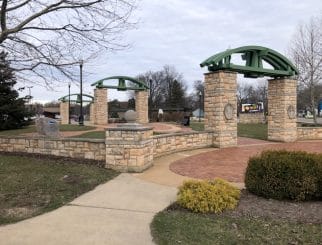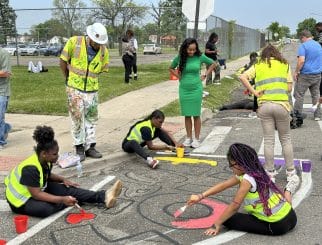East Side Water Main – Contract B
Spalding DeDecker (SD) completed the initial phase of surveying layout services for a tunnel under the Maumee River. The tunnel hosts a 48” diameter pre-cast concrete water main between the City of Toledo and Perrysburg Township.
Typically, as tunnel construction progressed, probe holes (small vertical shafts dug along the proposed tunnel centerline) were used to verify the location of the constructed tunnel. If the probe holes indicated that the tunnel was off center, small horizontal corrections were made. Because the tunnel was being constructed below a river, probe holes could not be used to verify the actual horizontal location of the tunnel. Because Global Positioning System (GPS) technology required line of sight to the satellites, GPS could not be used underground. Another method had to be used.
Complicating matters, a short back-sight created the potential for a huge horizontal error if projected out 1,600’. As a matter of reference, a standard survey baseline consisted of a long, back-sight which could be projected forward accurately for the same length. The initial back-site at the bottom of the shaft was barely 24’. The survey baseline had to be projected 1,600’ in order to hit the centerline of the shaft constructed on the other side of the river. A 24’ back-sight versus a 1,600’ fore-site after plumbing down a 90’ deep shaft would normally create the potential for a huge amount of error. A 1° error in sighting could have created a 28’ horizontal error in 1,600’. As a matter of reference, a standard survey baseline consisted of a long, back-sight which could be projected forward accurately for the same length.
The Solution: Surveying with “Old Technology”
To minimize any potential error, SD used a piece of surveying equipment typically used for mining that dates back at least to the 1960’s. It is called a Gyrocompass, usually referred to as a Gyroscope.
Several readings had to be taken at ground level to average the results even before entering the tunnel. The equipment was taken into the shaft, and the orientation process was repeated to once again point the instrument toward true north and then to the actual bearing of the survey baseline. Nails were set in the crown of the tunnel along the alignment every Saturday throughout the duration of the project at the back of the rock drilling/mining machine. To get beyond the machine, the survey technicians had to crawl through a 90’ long, 3’x 3’ opening carrying a bag full of tools through the conveyor system.
The tunnel was scheduled to hit the receiving shaft on May 10, 2006. The Contractor, Ric-Man Construction, Inc. called SD on May 9, 2006, ahead of schedule, and notified us that they had hit “right on the mark” after drilling through 1,600’ of dolomite.
The Construction Superintendent, Jim Bilicki exclaimed,
Just heard from Ohio. They hit the exit shaft dead center, on perfect line and grade. Congratulations! You guys did a hell of a job getting us across that river!
The team was elated that the equipment worked as anticipated, validating the initial computations were correct.


